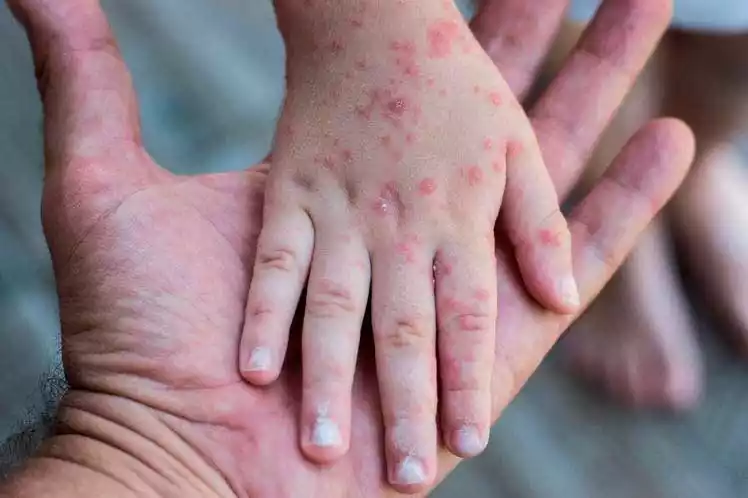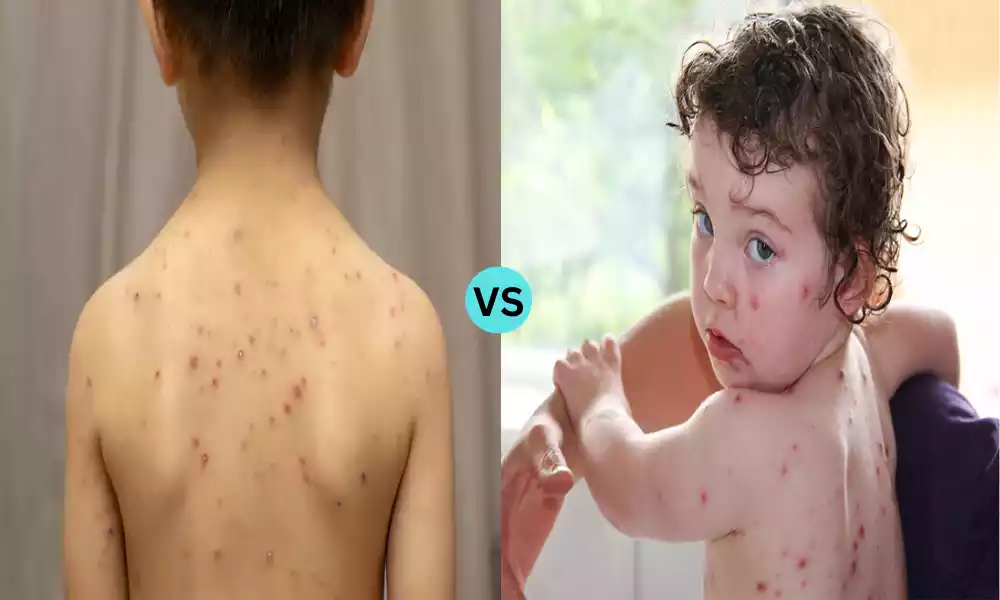Introduction of Monkeypox and Chickenpox
In the realm of infectious diseases, it is vital to accurately identify and diagnose conditions to ensure proper treatment and containment. Among viral infections, two illnesses, Monkeypox and Chickenpox, while sounding similar, are notably distinct in terms of causative agents, symptoms, and global health impact. This article delves deep into these two diseases, detailing their differences and highlighting why distinguishing between them is of paramount importance.
Definition of Monkeypox
Monkeypox is a rare and contagious viral disease caused by the monkeypox virus, a member of the Orthopoxvirus genus. First identified in monkeys in 1958, the disease was later discovered in humans in the Democratic Republic of the Congo in 1970. Presenting with flu-like symptoms including fever, headache, and muscle aches, the distinguishing feature of monkeypox is a pustular rash that spreads across the body.

While the disease shares some clinical similarities with smallpox, it is generally milder in nature. Transmission to humans typically occurs through direct contact with infected animals, particularly rodents, or through human-to-human transmission. Predominantly found in Central and West Africa, monkeypox has the potential to cause severe health complications, particularly in those with weakened immune systems.
Definition of Chickenpox
Chickenpox is a highly contagious viral infection caused by the varicella-zoster virus (VZV). It’s characterized primarily by the onset of a blister-like rash that appears first on the face and trunk, then spreads over the body. Along with the rash, individuals infected with chickenpox may experience fever, fatigue, headache, and loss of appetite.

Typically seen in children, chickenpox was once a common illness before the introduction of the varicella vaccine. While the disease is usually mild in children, complications can arise, and it can be more severe in adults, leading to issues such as pneumonia, encephalitis, and bacterial skin infections. After recovery, the varicella-zoster virus remains dormant in the body and can reactivate later in life to cause shingles.
Causes of Monkeypox and Chickenpox
Monkeypox:
- Causative Agent: Caused by the Monkeypox virus, a member of the Orthopoxvirus genus.
- Transmission: Typically transmitted to humans from rodents, primates, or through direct human-to-human contact.
Chickenpox:
- Causative Agent: Caused by the Varicella-Zoster Virus (VZV).
- Transmission: Highly contagious, spread easily through airborne droplets when an infected person coughs or sneezes. It can also be contracted by touching the rash or through contact with fluid from blisters.
Symptoms of Monkeypox and Chickenpox
Monkeypox:
- Fever
- Headache
- Muscle aches
- Fatigue
- Swollen lymph nodes
- Rash: Begins as papules, then turns into vesicles followed by pustules.
Chickenpox:
- Fever
- Fatigue
- Loss of appetite
- Headache
- Rash: Starts as red spots that become raised and form itchy blisters.
- Rash typically appears first on the abdomen or back and face, then spreads to almost all parts of the body.
Importance of Distinguishing Between Monkeypox and Chickenpox
- Treatment Approach: While neither disease has specific antiviral treatments, the approach to management differs. Monkeypox may occasionally warrant the use of antiviral medications, while Chickenpox in severe cases might require antiviral drugs like Acyclovir.
- Vaccination: The Chickenpox vaccine (Varivax) can prevent chickenpox. There’s no commercially available vaccine for Monkeypox, although the smallpox vaccine has shown some effectiveness against it.
- Containment: Given the potential severity and outbreak capability of Monkeypox, especially in regions unfamiliar with the disease, swift identification and containment become essential.
- Complications: Misdiagnosis can lead to improper patient care and a failure to address potential complications.
Comparison table of Monkeypox and Chickenpox
Here’s a comparison table outlining the key differences between Monkeypox and Chickenpox:
| Aspect | Monkeypox | Chickenpox |
|---|---|---|
| Causative Agent | Monkeypox virus (from Orthopoxvirus genus) | Varicella-zoster virus (VZV) |
| Primary Symptoms | Fever, headache, muscle aches, backache, swollen lymph nodes, rash | Itchy rash, blisters, fever, fatigue |
| Rash Progression | Begins on face, then spreads; evolves over time | Begins on face/trunk, spreads; blisters to scabs |
| Transmission | Direct contact with infected animals or humans, human-to-human transmission | Primarily human-to-human transmission |
| Geographical Prevalence | Central and West Africa (primarily) | Global |
| Complications | Can be severe, especially in immunocompromised individuals | Can be more severe in adults; risk of shingles later in life |
| Treatment | Supportive care | Antiviral medications (e.g., acyclovir), itch-relief treatments |
| Vaccine | No specific vaccine; smallpox vaccine offers some protection | Varicella vaccine |
| Mortality Rate | Low, but varies (1-10%) | Generally low, but higher in adults |
| Primary Source | Rodents and other small mammals in affected regions | Infected humans |
This table provides a concise overview of the distinctions between the two diseases, but it’s important to remember that both diseases have their nuances and complexities. Proper diagnosis and management require a comprehensive understanding beyond just these basic differences.
Similarities between Monkeypox and Chickenpox
- Rash as a Primary Symptom: Both diseases prominently feature a blister-like rash.
- Viral Diseases: Both are caused by viruses, necessitating similar precautionary measures like isolation.
- Flu-like Symptoms: Both conditions present symptoms such as fever and fatigue.
- Transmissibility: Both diseases can be spread through direct human-to-human contact, making containment crucial.
- Potential for Complications: If not managed correctly, both can lead to complications such as bacterial infections, pneumonia, or even encephalitis.
While Monkeypox and Chickenpox might share some similarities, they are distinct diseases with different implications for global health. Accurate identification, proper management, and informed public health strategies are vital for the well-being of affected individuals and communities at large.
Diagnosis of Monkeypox and Chickenpox
Here’s a the diagnosis methods for Monkeypox and Chickenpox:
Monkeypox:
- Clinical Presentation: Fever, headache, muscle aches, backache, swollen lymph nodes, followed by a rash that starts on the face and spreads.
- Laboratory Tests: Polymerase chain reaction (PCR) assays, enzyme-linked immunosorbent assay (ELISA), and virus isolation.
Chickenpox:
- Clinical Presentation: Characteristic itchy rash that progresses from spots to blisters to scabs, often accompanied by fever and fatigue.
- Laboratory Tests: Diagnosis is usually made clinically, but in uncertain cases, PCR, direct fluorescent antibody tests, and serological methods may be employed.
The clinical presentation plays a crucial role in initial diagnosis, but laboratory tests can provide definitive confirmation.
Treatment Approaches
Below is the treatment approaches of Monkeypox and Chickenpox:
Monkeypox:
- Supportive Care: Alleviate symptoms like fever and pain.
- Smallpox Vaccine: Potential preventive measure during outbreaks.
- Cidofovir: Experimental antiviral.
- Isolation: Prevent disease spread.
Chickenpox:
- Antiviral Medication: Acyclovir to reduce severity.
- Symptomatic Relief: Pain relievers for fever, calamine for itching.
- Hydration: Maintain fluid intake.
- Isolation: Contain spread until blisters crust.
- Vaccination: Preventive varicella vaccine.
Both diseases emphasize symptomatic relief, with some specific interventions depending on the disease. Prevention is a key component in managing both diseases.
Global Impact
The global impact of diseases can be assessed through their direct effects on health, economic implications, and broader societal repercussions. Both monkeypox and chickenpox have made significant marks on public health landscapes, though in different manners. Here’s a brief overview of their global impacts:
Monkeypox:
- Regional Focus with Global Implications: Historically confined to Central and West Africa, monkeypox has seen occasional cases outside this region, reminding global health authorities of the potential for diseases to cross borders in our interconnected world.
- Economic Impact: Outbreaks can strain local healthcare resources, leading to economic challenges in affected areas, particularly in regions with less robust healthcare infrastructures.
- Public Health Concern: Though less deadly than smallpox, the resemblance between the two has often caused panic. Moreover, its zoonotic nature poses challenges in containment.
- Surveillance and Response: The potential for monkeypox to spread necessitates global health surveillance systems, coordination between countries, and rapid response mechanisms.
Chickenpox:
- Universal Prevalence: Before the introduction of the varicella vaccine, chickenpox was ubiquitous, affecting individuals worldwide, irrespective of the region.
- Economic Burden: Chickenpox has often resulted in hospitalizations, especially among adults, leading to direct medical costs and productivity losses from missed workdays.
- Long-Term Health Implications: The varicella-zoster virus remains latent in the body, potentially reactivating later in life to cause shingles—a painful condition. This secondary manifestation has health and economic implications.
- Vaccination Campaigns: The introduction and global rollout of the varicella vaccine have transformed the landscape of chickenpox, leading to declines in cases, complications, and hospitalizations.
- Global Health Cooperation: The push for chickenpox vaccination is part of broader global health initiatives to combat infectious diseases and improve childhood health outcomes.
While monkeypox has had a more regionalized impact with concerns about potential global spread, chickenpox has had a historical widespread influence, now being mitigated through vaccination campaigns. Both diseases underscore the importance of global health collaboration, surveillance, and proactive measures to prevent and treat infectious diseases.
Prevention of Monkeypox and Chickenpox
Monkeypox Prevention:
- Avoid Animal Contact: Especially rodents and primates in endemic areas.
- Hand Hygiene: Regular and thorough handwashing.
- Isolation: Keep infected individuals isolated.
- Protective Equipment: Especially for healthcare workers.
- Smallpox Vaccine: Offers cross-protection against monkeypox.
- Health Education: Raise awareness in affected communities.
Chickenpox Prevention:
- Vaccination: Use of the varicella vaccine.
- Isolation: Infected individuals should avoid contact until blisters scab over.
- Avoid Risk Groups: Stay away from vulnerable individuals like pregnant women.
- Hand Hygiene: Regular handwashing.
- Routine Immunization: Integration of vaccine in national immunization programs.
Prevention for both revolves around vaccination (where available), minimizing exposure, and promoting hygiene.
Research and new Invention
Research and innovation play a pivotal role in addressing infectious diseases like monkeypox and chickenpox. Scientific advances not only enhance our understanding but also provide novel solutions for prevention, treatment, and containment.
Here’s an overview of research and inventions in the realm of monkeypox and chickenpox:
Monkeypox:
- Vaccination Research: While the smallpox vaccine provides some cross-protection against monkeypox, there is an interest in developing a monkeypox-specific vaccine for better efficacy and safety.
- Antiviral Agents: Drugs like cidofovir and its analogs have shown promise in vitro against monkeypox, paving the way for potential therapeutic options.
- Disease Modeling: With advancements in computational biology, models are being developed to predict monkeypox outbreaks and understand transmission dynamics.
- Diagnostics: Efforts are being made to enhance diagnostic accuracy, enabling rapid detection and differentiation from other similar diseases.
- Ecological Studies: Understanding the interaction between the virus and its animal reservoirs can provide insights into the disease’s ecology and potential preventive measures.
Chickenpox:
- Improved Vaccines: With the existing varicella vaccine being effective, research focuses on improving its longevity and investigating combination vaccines (e.g., MMRV, which combines measles, mumps, rubella, and varicella vaccines).
- Shingles Prevention: Given that the varicella-zoster virus can reactivate later in life causing shingles, there’s a shingles vaccine (Shingrix) developed for older adults, which is a product of extensive research.
- Antiviral Developments: While drugs like acyclovir are effective against chickenpox, research continues to refine these drugs and explore new antiviral agents.
- Pathogenesis Understanding: Studies to comprehend how the varicella-zoster virus interacts with the human body can provide insights into potential therapeutic targets.
- Post-Infection Complications: Research on the long-term implications of chickenpox and how to prevent or treat conditions like shingles, postherpetic neuralgia, and other complications.
Both diseases, despite differing in global prevalence and impact, benefit immensely from ongoing scientific inquiry. As research progresses, it holds the promise of better preventive measures, improved treatments, and a deeper understanding of the diseases’ intricacies.
Summary
Although monkeypox and chickenpox may appear similar at first glance, understanding their differences is essential for effective treatment and prevention. With advancements in medical science, more tools are becoming available to manage and prevent these diseases, emphasizing the importance of accurate information and awareness.



